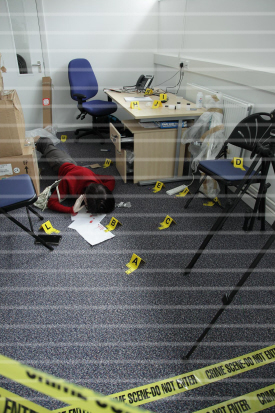Chapter 1: Assessing the Crime Scene
KEY LEARNING
You should be able to:
State the meaning of FOA, and at least three of the roles of the FOA
State some of the steps carried out by a CSI during their initial assessment of a crime scene
Explain the meaning of CAP and the consequences of not using a CAP
State the meaning of the Health and safety terms: COSHH, DSEAR
Part 2) Assessing the Crime Scene:
The CSI will make an initial assessment of the scene to confirm that a crime has actually taken place. This has often already been established by the first officer attending (FOA) the scene, or by Force Control who will have taken information from the complainant in order to assess the nature of the allegations and crime. The CSI will then (very carefully) walk through the scene and assess the scene forensically. They will need to:
Reassess the initial action taken by FOA to preserve evidence
Review the extent of scene by questioning the victim/witness and visual examination
Establish scene boundaries and a CAP (common approach path)
- Establish the points of entry and egress
Assess: the potential evidence at the scene ( e.g. cigarette ends, cans, bottles, and tools),
Assess: the recovery techniques required, and
Assess: any specialist equipment/support needed)
Identify any items that may have been left at the scene by suspect/s
Consider health and safety risks
Last but not least! Assessing the risks to the CSI's health and safety when he or she begins to process the scene in which hazardous substances or other dangers may be present is vital. Those dangers could include loose flooring, or sharp objects such as broken glass, or even the presence of the perpetrator of the crime who might be in hiding, or simply remaining in the area to "see" whether their actions have been discovered! The CSI must take all necessary steps to minimise harm to by complying with the relevant legislation such as The Control of Substances Hazardous to Health (COSHH) Regulations, or The Dangerous Substances and Explosive Atmospheres (DSEAR) Regulations, and others. Details about these regulations can be found HERE. Only when the CSI is satisfied that they have all the information they need to safety process the scene will they begin to do so.
ASSESSING THE SCENE
Since most investigations start with very limited information, care and common sense are necessary to minimize the chances of destroying evidence
A plan of operation is developed and initiated following the initial “walk” through of the scene.
When assessing the crime scene, the plan is to decide:
What evidence may be present
What evidence may be fragile and need to be collected as soon as possible
What resources, equipment, and assistance are necessary for processing the scene
----------------------------------------------
THIS SCENE HAS ALREADY BEEN ASSESSED, SECURED AND MARKED-UP
